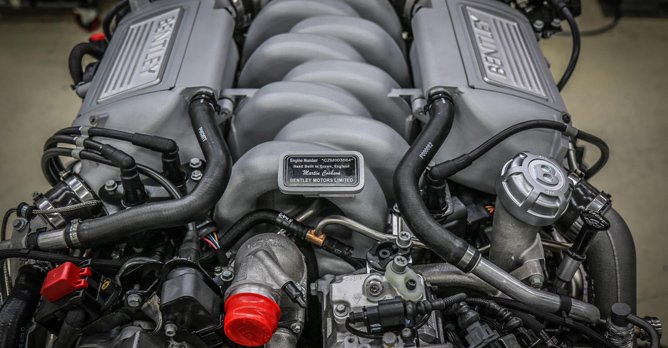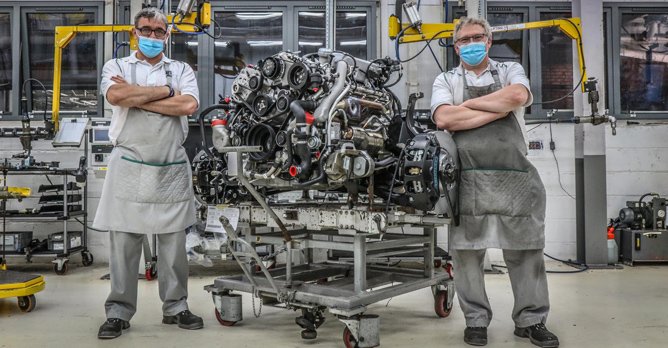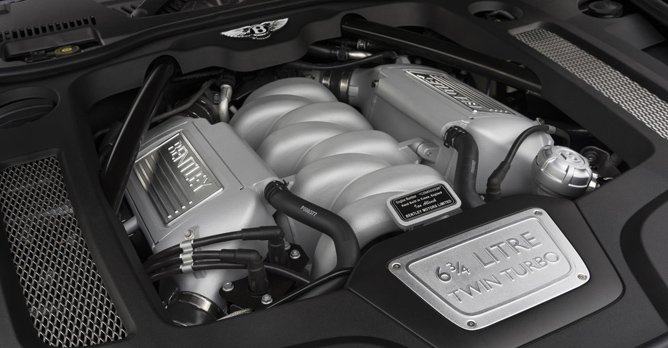Bentley's last Great Eight engine reaches the end of production
04 Jun 2020|343 views
The mighty Bentley 6.75-litre V8 engine - the longest serving V8 design in continuous production - has finally reached the end of its handcrafted manufacturing run.
The final engine was assembled in Crewe on 1 June 2020 by the dedicated team of seven people, who between them have a combined experience of 105 years building Bentley's iconic V8 engine.
In production for more than 60 years, and with the same configuration and bore spacing as the very first version from 1959, the last L-Series engine will spend its life powering the 30th and last specially commissioned Mulsanne 6.75 Edition by Mulliner.
This bespoke series closes the Mulsanne's production run, and celebrates the life of its iconic engine with a myriad of V8-inspired details, including badging, blueprint graphics and even ventilation 'organ stops' featuring a miniature version of the oil cap.
Originally designed by a team of Bentley engineers in the 1950s to deliver a step change in performance over the straight six it replaced, the L-Series V8 first saw service in the 1959 Bentley S2 - developing around 180bhp, deemed 'adequate' by Bentley at the time.
Since then, through the advent of continual design improvement, turbocharging, electronic control systems, fuel injection and variable valve timing the modern descendant of that original engine has evolved into something truly extraordinary. Developing 530bhp for the Mulsanne Speed, together with an astonishing 1,100Nm of torque, the low-revving engine delivers a unique character that defined the widely-recognised 'wave of torque' that all Bentleys now ride. At the same time, emissions have been drastically reduced, with the modern engine producing 99% fewer harmful emissions than its forebear.

Even the modern engine takes 15 hours to build, and the key internal components are individually chosen to form a matching, balanced set so that the engine runs perfectly smoothly - a skill that takes years to perfect.
Once completed, and after thorough testing, the engine is signed off by one of Bentley's engine specialists, as it has been for decades - with a plate denoting their signature affixed to the front of the engine. With the Mulsanne completing production once the thirty 6.75 Edition cars are built, the all new Flying Spur will become Bentley's flagship model, as the pinnacle of Bentley's exquisite range of luxurious cars.
With the Flying Spur to receive a hybrid powertrain by 2023, the move symbolises Bentley's commitment to change and its journey to define the future of sustainable luxury mobility. The world's most sought-after luxury car brand has already taken its first step on the road towards electrification with the launch of the Bentayga Hybrid - the luxury SUV sector's first, true plug-in hybrid and the most efficient Bentley ever.
The development of the first Bentley V8 engine began not long after the company moved to its current headquarters in Crewe. A 'V' configuration was the natural choice and it is a testament to Phillips and his team that the engine ran just 18 months after the start of the design process.
The resulting 6.2-litre V8 engine was 13.6kg lighter than the six-cylinder model. The engine design team focused on improving performance, while reducing the overall engine dimensions to fit the space available under a lowered bonnet.
Engine capacity was increased to the eponymous 6.75-litres in 1971 through an increase in stroke from 9.1cm to 9.9cm that delivered even more torque. The latter included a collapsible water pump, which effectively shortened the engine by 10cm.
The biggest single change to the engine was for the launch of the Mulsanne Turbo. With the fitment of a large single turbocharger, the 6.75-litre engine become the first forced-induction Bentley engine since those that powered Tim Birkin's Blower Bentleys of the 1920s.
With the modernisation of the Crewe facility from 1998 and an increase in production, the V8 engine also underwent on-going development. Power stayed above 500bhp, while torque figures peaked at 1,100Nm - for a time, the L-series V8 made more torque than any other automotive engine in the world. The engine now reaches the end of its development and production run, but will live in for decades to come in the beloved cars of Bentley's customers.
The mighty Bentley 6.75-litre V8 engine - the longest serving V8 design in continuous production - has finally reached the end of its handcrafted manufacturing run.
The final engine was assembled in Crewe on 1 June 2020 by the dedicated team of seven people, who between them have a combined experience of 105 years building Bentley's iconic V8 engine.
In production for more than 60 years, and with the same configuration and bore spacing as the very first version from 1959, the last L-Series engine will spend its life powering the 30th and last specially commissioned Mulsanne 6.75 Edition by Mulliner.
This bespoke series closes the Mulsanne's production run, and celebrates the life of its iconic engine with a myriad of V8-inspired details, including badging, blueprint graphics and even ventilation 'organ stops' featuring a miniature version of the oil cap.
Originally designed by a team of Bentley engineers in the 1950s to deliver a step change in performance over the straight six it replaced, the L-Series V8 first saw service in the 1959 Bentley S2 - developing around 180bhp, deemed 'adequate' by Bentley at the time.
Since then, through the advent of continual design improvement, turbocharging, electronic control systems, fuel injection and variable valve timing the modern descendant of that original engine has evolved into something truly extraordinary. Developing 530bhp for the Mulsanne Speed, together with an astonishing 1,100Nm of torque, the low-revving engine delivers a unique character that defined the widely-recognised 'wave of torque' that all Bentleys now ride. At the same time, emissions have been drastically reduced, with the modern engine producing 99% fewer harmful emissions than its forebear.

Even the modern engine takes 15 hours to build, and the key internal components are individually chosen to form a matching, balanced set so that the engine runs perfectly smoothly - a skill that takes years to perfect.
Once completed, and after thorough testing, the engine is signed off by one of Bentley's engine specialists, as it has been for decades - with a plate denoting their signature affixed to the front of the engine. With the Mulsanne completing production once the thirty 6.75 Edition cars are built, the all new Flying Spur will become Bentley's flagship model, as the pinnacle of Bentley's exquisite range of luxurious cars.
With the Flying Spur to receive a hybrid powertrain by 2023, the move symbolises Bentley's commitment to change and its journey to define the future of sustainable luxury mobility. The world's most sought-after luxury car brand has already taken its first step on the road towards electrification with the launch of the Bentayga Hybrid - the luxury SUV sector's first, true plug-in hybrid and the most efficient Bentley ever.
The development of the first Bentley V8 engine began not long after the company moved to its current headquarters in Crewe. A 'V' configuration was the natural choice and it is a testament to Phillips and his team that the engine ran just 18 months after the start of the design process.
The resulting 6.2-litre V8 engine was 13.6kg lighter than the six-cylinder model. The engine design team focused on improving performance, while reducing the overall engine dimensions to fit the space available under a lowered bonnet.
Engine capacity was increased to the eponymous 6.75-litres in 1971 through an increase in stroke from 9.1cm to 9.9cm that delivered even more torque. The latter included a collapsible water pump, which effectively shortened the engine by 10cm.
The biggest single change to the engine was for the launch of the Mulsanne Turbo. With the fitment of a large single turbocharger, the 6.75-litre engine become the first forced-induction Bentley engine since those that powered Tim Birkin's Blower Bentleys of the 1920s.
With the modernisation of the Crewe facility from 1998 and an increase in production, the V8 engine also underwent on-going development. Power stayed above 500bhp, while torque figures peaked at 1,100Nm - for a time, the L-series V8 made more torque than any other automotive engine in the world. The engine now reaches the end of its development and production run, but will live in for decades to come in the beloved cars of Bentley's customers.
Latest COE Prices
May 2025 | 1st BIDDING
NEXT TENDER: 21 May 2025
CAT A$103,009
CAT B$119,890
CAT C$62,590
CAT E$118,889
View Full Results Thank You For Your Subscription.























